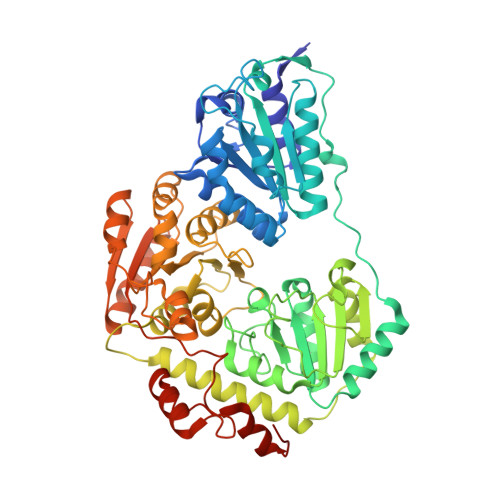The catalytic cycle of a thiamin diphosphate enzyme examined by cryocrystallography.
Wille, G., Meyer, D., Steinmetz, A., Hinze, E., Golbik, R., Tittmann, K.(2006) Nat Chem Biol 2: 324-328
- PubMed: 16680160
- DOI: https://doi.org/10.1038/nchembio788
- Primary Citation of Related Structures:
2EZ4, 2EZ8, 2EZ9, 2EZT, 2EZU - PubMed Abstract:
Enzymes that use the cofactor thiamin diphosphate (ThDP, 1), the biologically active form of vitamin B(1), are involved in numerous metabolic pathways in all organisms. Although a theory of the cofactor's underlying reaction mechanism has been established over the last five decades, the three-dimensional structures of most major reaction intermediates of ThDP enzymes have remained elusive. Here, we report the X-ray structures of key intermediates in the oxidative decarboxylation of pyruvate, a central reaction in carbon metabolism catalyzed by the ThDP- and flavin-dependent enzyme pyruvate oxidase (POX)3 from Lactobacillus plantarum. The structures of 2-lactyl-ThDP (LThDP, 2) and its stable phosphonate analog, of 2-hydroxyethyl-ThDP (HEThDP, 3) enamine and of 2-acetyl-ThDP (AcThDP, 4; all shown bound to the enzyme's active site) provide profound insights into the chemical mechanisms and the stereochemical course of thiamin catalysis. These snapshots also suggest a mechanism for a phosphate-linked acyl transfer coupled to electron transfer in a radical reaction of pyruvate oxidase.
Organizational Affiliation:
Institut für Biochemie, Martin-Luther-Universität Halle-Wittenberg, Kurt-Mothes-Str. 3, 06120 Halle/Saale, Germany. [email protected]


















